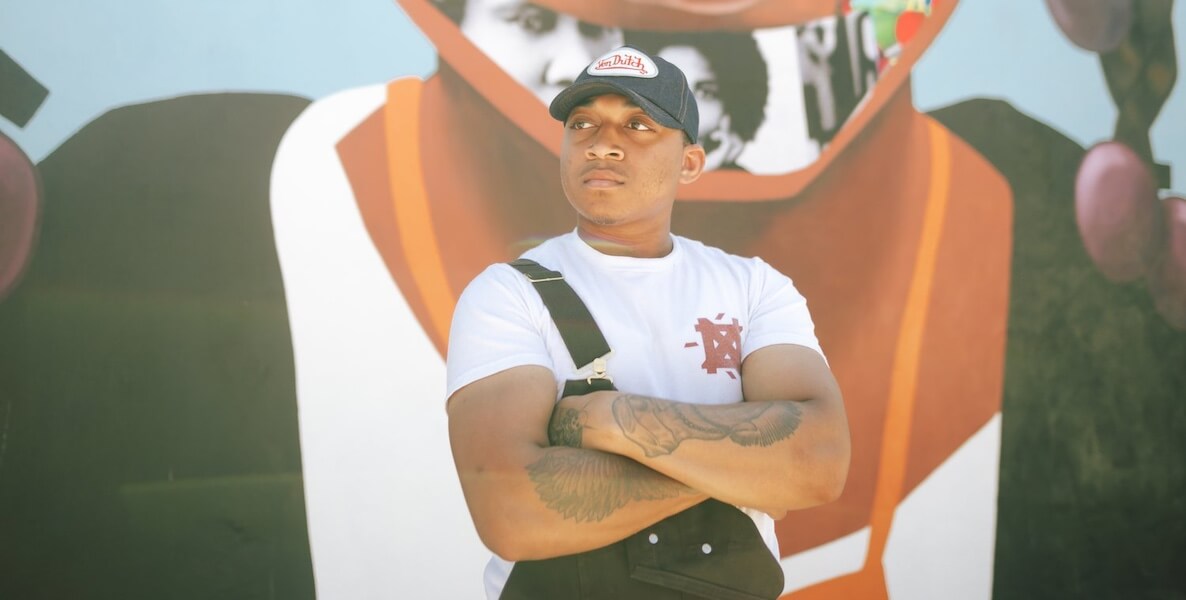Nazeer Sabree is a painter, filmmaker and collage artist whose work explores the pressures and joys of Black life. Best known for his False Face portraits, Sabree draws on the contradiction that masks can reveal even more than they hide. Starting with traditionally painted portraits of young men and women, Sabree covers his subjects’ faces with masks made of collaged photographs culled from history, the headlines, and social media. The result is a complex examination of individual identities constructed by societal norms and cultural moments.
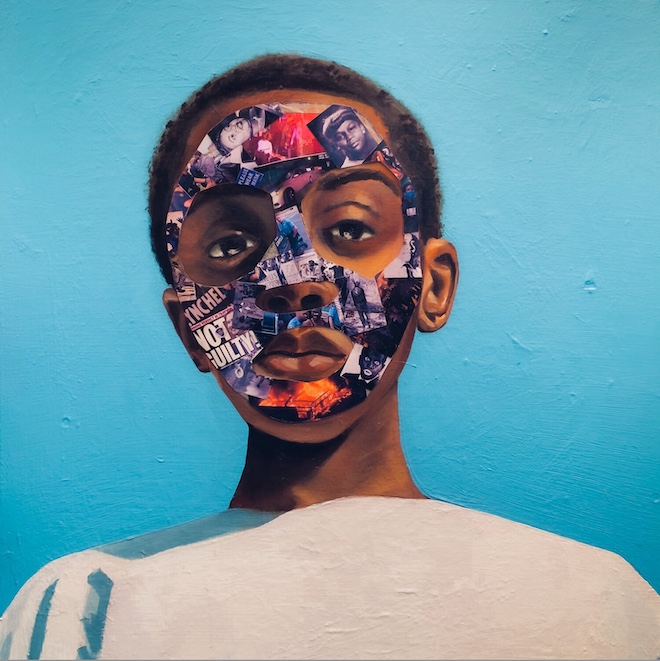
Sabree cites the music, fashion, and societal expectations he experienced growing up between West and North Philadelphia as his main influences. He speaks about meeting potential portrait subjects today, only to realize that a decade ago they were rivals who might have gotten in a fight. Through his artwork, Sabree explores constructs of masculinity and reexamines those formative experiences. Like so many artists getting their start in Philadelphia, Sabree has been a part of the extended Mural Arts Philadelphia network for years, both as an instructor in their art education program and as a 2020 recipient of the Philadelphia Fellowship for Black Artists.
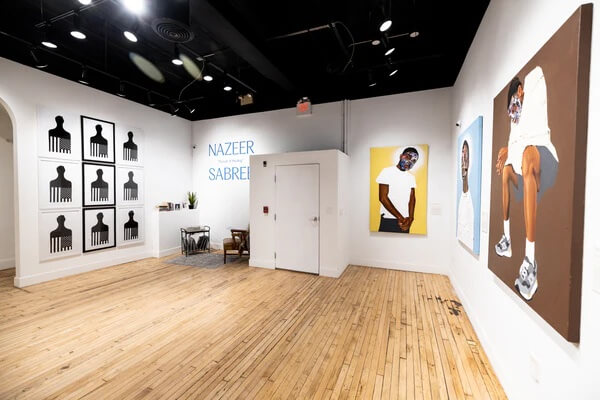
Still only 25 years old, Sabree is one of the city’s most buzzed-about young artists. In addition to the paintings he is known for, he has begun to expand into digital collage, public art, and filmmaking. Pursuit of Healing, the artist’s first solo exhibition, immediately sold out in April 2023 at Paradigm Gallery + Studio, and this month he has been working with the Philadelphia Museum of Art as part of their Black History Month programming, including curating a Spotify playlist for the museum.
As part of a partnership with Forman Arts Initiative, the Citizen caught up with Nazeer Sabree. The interview has been condensed and edited for clarity.
RJ Rushmore: You and I first met when you painted a mural in Fishtown of a young girl with a mask full of images depicting influential Black women and examples of Black excellence. What a fantastic project. How did that come about?
Nazeer Sabree: That was Ginger [Rudolph], StreetsDept, and Living Walls who put together the Adult Swim Mural Project. Early on, Ginger told me, “You may have this thing coming up. Make sure you come correct.” That’s Ginger’s whole protocol. When I presented my initial design, the curators weren’t too crazy about it. I had made the mistake of making work for the audience instead of making work for myself.
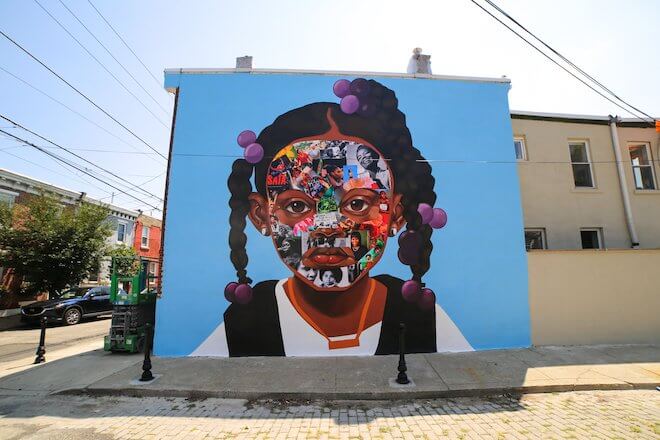
So I started to lean into what I was reading, which was a lot of bell hooks, Maya Angelou, and Gwendolyn Brooks, three different women who have influenced me. I also grew up in a matriarchal home. The men in my life were locked up. All of that led me to a mural about Black girls and women, which I named after my sister Monee. That concept resonated. What the mural did was give young people in Fishtown, particularly young women of color in this area that has historically been very racist, a sense of pride.
What is your full process of making an artwork?
The False Face series is what got people to notice me, so let’s use that as an example. That started with photographing somebody in my real life, painting a portrait that represents them in an honorable way, engulfing them in a cerulean blue background, and then putting them inside this white T-shirt. The shirt was painted a flat white but it was made out of fabric scraps that I glued onto the canvas, which was a way of talking about the relationship between fashion and survival in the communities I grew up in. On the faces, I made collaged masks from my photo archives. Those images come from things that I’ve collected from social media, photos from magazines and newspapers, or even just screenshots of random things on my phone. I print those out and piece them together. I glue that collage right on top of the portrait and seal the whole thing up.
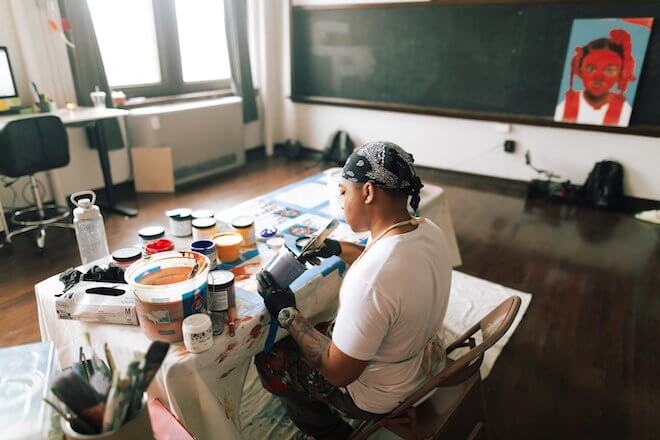
With those masks, which have become your trademark motif, what are you depicting?
The mask you have got to wear to survive. It’s about masking emotionally, but also about how the trauma that you see builds up and shapes your experience of the world. When I was growing up, I didn’t think about my life in a valuable way. When I saw people getting jumped, I didn’t respect myself enough to identify that something was wrong there. It just felt like that’s the way life is. I didn’t think anything was wrong with that until I got introduced to a different thing.
You’ve had a big year. It started with a solo show at Paradigm Gallery last April, and now you’re collaborating with the Philadelphia Museum of Art on their Black History Month programming. Pursuit of Healing was the first exhibition in Paradigm Gallery’s new Old City location. What was it like to christen Paradigm’s upgraded space?
I’m still processing it. The outcome is something that I wanted, I prayed for, I worked for, but I almost didn’t expect that to happen. That show sold out in 48 hours and 1,500 people showed up. It still doesn’t feel real. I’m blessed. For that, I want to say thank you to Ginger Rudolph, who curated that show, and my Paradigm family. If it wasn’t for Ginger, I wouldn’t even be in this predicament. To be 25 and be doing what I’m doing, it’s a lot.
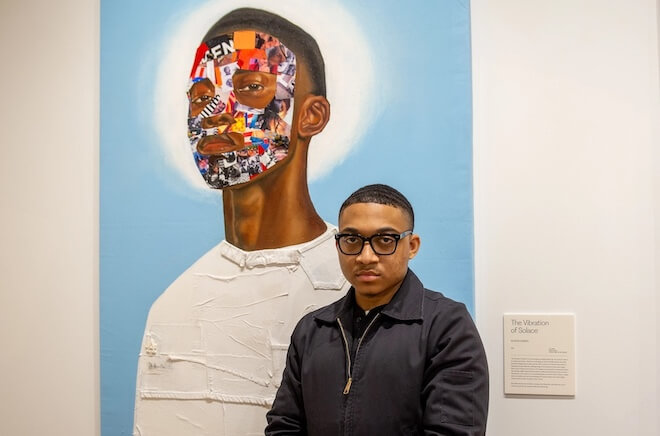
The way that you combine collage and portraiture can really stop a viewer in their tracks. Beyond that immediate hook, what are you hoping for when people take their time with your artwork?
I’m still learning about that relationship between me, the artwork and the audience. When I was working as an illustrator, I was creating for someone else. When I started making art, I asked myself, “How do I paint for Nazeer?” I went through a lot of my life masking my own emotions and not being able to be vulnerable. Art has given me a chance to express myself safely and honestly. And there is a duality of being extremely vulnerable while at the same time cloaking that vulnerability with a mystique. I have found that I’m not only painting for myself. I’m painting for anyone who sees themselves in what I make. Maybe that makes people feel like they’re not alone.
I see a lot of healing and vulnerability in your artwork. Is healing an ongoing process for you?
Definitely. I am still finding out how to be okay with being myself and the things that I’ve been through. Healing has no final destination. It comes in stages and every stage ain’t the best. Some things are raw and upfront. Sometimes you gotta get close up with those difficult emotions to see what’s really going on.
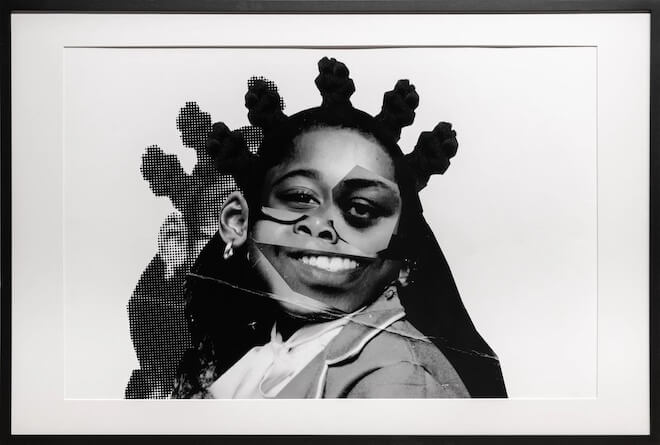
How does making art do that for you?
Art helps me piece together things that got foggy in my mind. It is allowing me to look back at traumatic experiences and piece them together. It’s also allowing me to have grace with myself about mistakes that I made when I was younger.
I’m able to do that by investigating myself, my life and the people around me, as well as what’s going on socially and politically. Making art is like being in a therapy session with God. I can talk about my most vulnerable moments in my life and not be judged or condemned. Instead, I’m understood and embraced. That whole creative process is crucial to who I am as a person.
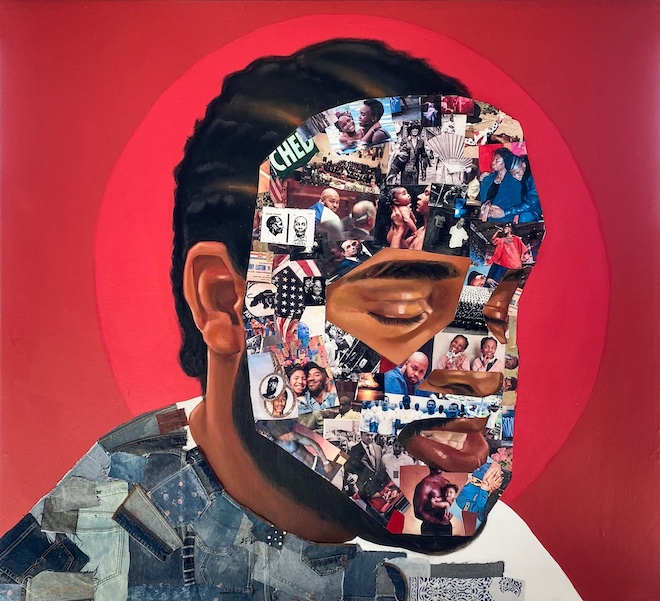
Speaking of the people around you, are your portraits of specific people?
These days they are. I sit down with people to make photo references that I paint from. People come into the studio, I take photos, we talk for two or three hours, and it evolves from there. When I do that, I’m not just taking photos. I’m hearing stories. They’re telling me about what they’re going through, or as we’re talking we discover that we know some of the same people or maybe we almost got into a fight when we were teenagers. And all of that makes the painting even richer. I’m not just putting my stuff on some random figure. Instead, I’m telling my story and also that person’s story.
RJ Rushmore is a writer, curator and public art advocate. He is the founder of the street art blog Vandalog and culture-jamming campaign Art in Ad Places. As a curator, he has collaborated with Poster House, Mural Arts Philadelphia, The L.I.S.A. Project NYC and Haverford College. Rushmore’s writing has appeared in Hyperallergic, Juxtapoz, Complex and numerous books. He holds a B.A. in Political Science from Haverford College, where his thesis investigated controversies in public art.
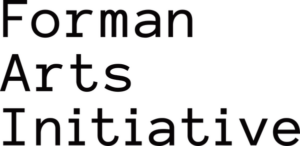
This story is part of a partnership between The Philadelphia Citizen and Forman Arts Initiative to highlight creatives in every neighborhood in Philadelphia. It will run on both The Citizen and FAI’s websites.
![]() MORE FROM OUR ART FOR CHANGE SERIES
MORE FROM OUR ART FOR CHANGE SERIES



